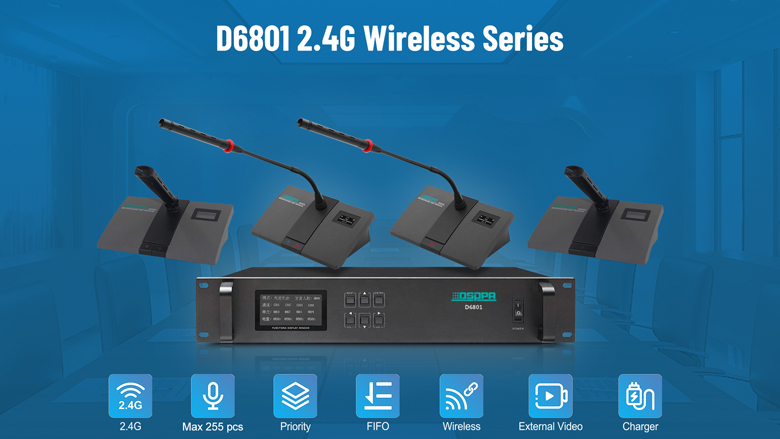
The invention of conference room wireless microphone dates back to 1909, with a history of over 100 years. In today's rapidly developing information age, multimedia conference systems demand higher speeds and management efficiency for information transmission. To achieve "reduced costs and increased efficiency" in the use of conference recording equipment, system management, and maintenance, wireless microphones for conference rooms are widely used across various industries due to their simplicity, mobility, and easy installation.
Conference room wireless microphones have developed various categories due to technological advancements and application needs, such as VHF, UHF, infrared, 2.4G, and 5G. The application of wireless frequencies in conference systems covers multiple technologies from low to ultra-high frequencies. Each technology has its specific advantages and application scenarios to meet different speaking and sound pickup requirements. In terms of appearance, wireless microphones for conference rooms come in various forms, including handheld, head-worn, lavalier, gooseneck, and short rod, to suit different speaking needs.
Based on the advantages and applicable ranges of transmission signal bands:
Infrared transmission utilizes electromagnetic radiation with wavelengths longer than visible red light, with frequencies above 2 MHz. Infrared cannot penetrate walls, thus providing excellent confidentiality and resistance to radio interference and eavesdropping. Due to its stable performance and better sound quality, infrared wireless conference systems and infrared simultaneous interpretation systems have emerged. However, the drawbacks of infrared, such as susceptibility to strong light interference and obstruction by objects, are the main reasons for its limited application.
VHF band (30-300 MHz) Very High Frequency transmission: often referred to as "V band", primarily used in radio communications, broadcasting, navigation, etc. The propagation characteristics of the V band include line-of-sight propagation and relatively weak diffraction abilities, suitable for short-distance communications and close-range navigation. Compared to the U band, the V band has a lower frequency and weaker penetration but better diffraction capability, making it suitable for open areas or conditions with good visibility. Early applications, such as in educational settings, often used low-cost V band conference room wireless microphone.

UHF band (300-3000 MHz) Ultra High Frequency transmission: often referred to as "U band", conference room wireless microphones commonly use frequency bands mostly between 500-900MHz, suitable for small-scale audio transmission with analog FM modulation technology and products with relatively small information data volumes. Its advantages lie in strong signal diffraction capability, but with a lower data transfer rate, it is difficult to meet the needs of digital systems with large data volumes. The commonly seen wireless handheld, head-worn, and lavalier microphones mostly use U band wireless technology.

2.4G transmission: 2.4G band is between 2.405GHz and 2.485GHz. As a professional conference system manufacturer, we have developed a new type of conference room wireless microphones based on 2.4G wireless technology. This band is an internationally designated free band, providing favorable conditions for the potential development of 2.4G wireless technology. It features strong anti-interference capability and a maximum transmission distance of up to 100 meters.

5G transmission: 5G band is between 5.150GHz and 5.825GHz. Conference room wireless microphones have the advantage of higher frequencies, less interference, and generally better signal quality. However, the signal coverage range of the 5G frequency is relatively short, making it suitable for small areas of wireless coverage.